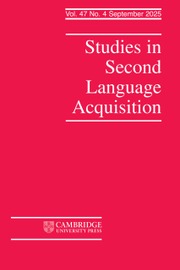Crossref Citations
This article has been cited by the following publications. This list is generated based on data provided by
Crossref.
Macrory, Gee
and
Stone, Valerie
2000.
Pupil progress in the acquisition of the perfect tense in French: the relationship between knowledge and use.
Language Teaching Research,
Vol. 4,
Issue. 1,
p.
55.
Bitan, T.
and
Karni, A.
2004.
Procedural and declarative knowledge of word recognition and letter decoding in reading an artificial script.
Cognitive Brain Research,
Vol. 19,
Issue. 3,
p.
229.
Wang, Min
Liu, Ying
and
Perfetti, Charles A.
2004.
The Implicit and Explicit Learning of Orthographic Structure and Function of a New Writing System.
Scientific Studies of Reading,
Vol. 8,
Issue. 4,
p.
357.
Van Den Branden, Kris
2007.
Practice in a Second Language.
p.
161.
Dekeyser, Robert M.
2007.
Practice in a Second Language.
p.
19.
Washio, Yukiko
and
Houmanfar, Ramona
2007.
Role of Contextual Control in Second Language Performance.
The Analysis of Verbal Behavior,
Vol. 23,
Issue. 1,
p.
41.
Dekeyser, Robert M.
2007.
Practice in a Second Language.
p.
139.
Leow, Ronald P.
2007.
Practice in a Second Language.
p.
21.
Eckerth, Johannes
2008.
Investigating consciousness‐raising tasks: pedagogically targeted and non‐targeted learning gains.
International Journal of Applied Linguistics,
Vol. 18,
Issue. 2,
p.
119.
Roehr, Karen
2008.
Linguistic and metalinguistic categories in second language learning.
Cognitive Linguistics,
Vol. 19,
Issue. 1,
Ellis, Nick C.
2008.
Encyclopedia of Language and Education.
p.
1878.
Zyzik, Eve
2008.
A Novel Format for Teaching Spanish Grammar: Lessons from the Lecture Hall.
Foreign Language Annals,
Vol. 41,
Issue. 3,
p.
434.
Rankin, Tom
2013.
Universal Grammar and the Second Language Classroom.
Vol. 16,
Issue. ,
p.
57.
Langer, Bradley D.
2013.
Teaching Requests to L2 Learners of Spanish.
Journal of Language Teaching and Research,
Vol. 4,
Issue. 6,
PRESSON, NORA
MacWHINNEY, BRIAN
and
TOKOWICZ, NATASHA
2014.
Learning grammatical gender: The use of rules by novice learners.
Applied Psycholinguistics,
Vol. 35,
Issue. 4,
p.
709.
Tellis, Cari M.
2014.
Integrated Implicit-Explicit Learning Approach to Voice Therapy.
Perspectives on Voice and Voice Disorders,
Vol. 24,
Issue. 3,
p.
111.
Scheffler, P.
2015.
Lexical priming and explicit grammar in foreign language instruction.
ELT Journal,
Vol. 69,
Issue. 1,
p.
93.
Ellis, Nick C.
2015.
Language Awareness and Multilingualism.
p.
1.
Teixeira, Annalisa
2015.
The role of aural recognition in L2 Spanish mood selection.
Revista Española de Lingüística Aplicada/Spanish Journal of Applied Linguistics,
Vol. 28,
Issue. 2,
p.
555.
Ellis, Nick C.
2016.
Language Awareness and Multilingualism.
p.
1.

